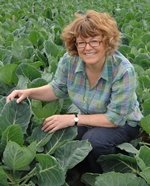Plugging the leek

The leek: Ubiquitous winter vegetable; Good in stews and soups; National symbol of Wales. You probably don’t give the leek much thought.
The leek is an important vegetable to the UK. It is a crop which British farmers grow well – approximately 2,000 ha of leeks are planted each year, producing between 40,000-50,000 tonnes per annum.
Leek production hasn’t always been plain sailing though, as the varieties farmers grew showed a lot of variation in vigour, size and uniformity. Growers were desperate for varieties which were more uniform so growing, packing and supply could become more efficient.
Discovery
25 years ago, after painstaking and detailed research by scientists at Horticulture Research International Wellesbourne, now part of the School of Life Sciences at the University of Warwick, a discovery was made which changed the face of commercial leek production.
Previously all leeks were bred using open pollination which caused the huge plant-to-plant variation, meaning the quality and uniformity of a single field of leeks could vary massively. This ended with a lot of wastage and impacted on the grower’s bottom line. In the early 90s plant genetics experts at HRI developed a male sterile leek – a plant which does not produce pollen and therefore cannot breed by open pollination. The development of the male sterile line opened the gates for the production of the F1 hybrid leek.
Dr Graham Teakle, plant breeding and genetics expert from the School of Life Sciences, explains: “F1 hybrid plants are the product of crossing a female plant that does not produce pollen (known as a male sterile line) with a pollen-producing male line. The resulting F1 hybrids tend to give higher yields due to a process called hybrid vigour - which is not fully understood. In the case of leeks these hybrids were more uniform giving fields of evenly sized plants. This was what the market was after, but the ability to produce an F1 hybrid leek had eluded people for years because it was difficult to identify a male sterile line.”
Meticulous research
The team at HRI Wellesbourne spent three years undertaking meticulous research, screening thousands of leeks to identify a sterile line that was stable (expressed the same features consistently), easy to multiply and of course, good for eating. A single line – WR1ms – was found to tick all the boxes. Crossing with the WR1ms line resulted in 60% higher yields compared to commercial varieties and a huge reduction in the variation in plant weight.
The rights to the breeding material involved in F1 hybrid production was put out to tender and were granted to Nunhems in 1993 and the company subsequently developed commercial varieties of hybrid leek using this material.
Impact of research
Today around 99% of all leeks grown and consumed are hybrids, demonstrating the impact the research has had. In addition, it has facilitated the creation of new products such as pre-packaged leeks – only possible with a highly uniform crop.
Dr Rosemary Collier of the Warwick Crop Centre, University of Warwick, concludes: “The F1 hybrid leek story highlights how innovative horticultural research can have a huge commercial impact and ultimately change both farming practices and public consumption.
“Current research on vegetable crops at the University of Warwick continues to support the commercial sector in the delivery of a reliable supply of safe, healthy and nutritious food to consumers.
“So next time you pick up a pack of three neat cylindrical leeks at your local supermarket, remember there’s a lot more to their appearance than meets the eye.”
 A celebratory event to mark the 25th anniversary of a hugely successful partnership between academia and industry, and a discovery which changed modern farming practices worldwide, will takes place on 3 October 2018 at the University of Warwick.
A celebratory event to mark the 25th anniversary of a hugely successful partnership between academia and industry, and a discovery which changed modern farming practices worldwide, will takes place on 3 October 2018 at the University of Warwick.
The event, held at Warwick’s Wellesbourne Campus, will re-unite Brian Smith, research leader in the Breeding and Genetics department at HRI and Toon Van Doormalen, plant breeder for Nunhems Seeds. It was Mr Smith and members of the allium breeding team, who first developed the breeding material, and Mr Van Doormalen was the first commercial breeder of hybrid varieties.
The event is being hosted by the University of Warwick at its Wellesbourne Campus, which is also home to the Defra-funded UK Vegetable Gene Bank.
Published:
2 October 2018
Contributers:
 Dr Graham Teakle is a plant biologist in the School of Life Sciences , whose focus is on the genetic analysis of crop traits.
Dr Graham Teakle is a plant biologist in the School of Life Sciences , whose focus is on the genetic analysis of crop traits.
 Dr Rosemary Collier is a research entomologist based at the Warwick Crop Centre, on Warwick's Wellesbourne Campus.
Dr Rosemary Collier is a research entomologist based at the Warwick Crop Centre, on Warwick's Wellesbourne Campus.
Terms for republishing
The text in this article is licensed under a Creative Commons Attribution 4.0 International License (CC BY 4.0).
Share

